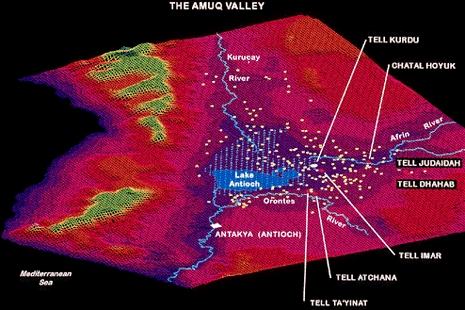|
Other Archaeological Sites / The Neolithic of the Levant (500 Page Book Online) Amuq Valley History and Archaeology Keywords = Amuq Valley / Plain of Antioch / Amik Ovasi
Major Excavated Sites: Tell Atchana / Tell Kurdu / Tell Judaidah / The Amuq Valley Regional Projects Excerpts and Definitions and Addendums:
Today the Amuq is a broad plain extending some 30 X 30 kilometres between the Amanus Mountains to the west in Turkey and a series of low limestone hills mainly within Syria to the south and east. Countless migrating people and animals have moved along this natural corridor and its landscapes have provided unique combinations of resource niches for human exploitation including both abundant agriculture and transhumant pastoralism ... ADDENDUM: Ancient Antioch (Antakya) was captured by the Turks in 1516 and it remained a part of the Ottoman Empire until shortly after World War I when it was conveyed to Syria under a French mandate. On September 2nd 1938 the French turned the Alexandretta district of the Syrian Republic into the autonomous Republic of Hatay. It was thereafter handed to Turkey on June 23rd 1939 (*) ... The new political boundaries left 24 of the 178 sites originally surveyed by Robert Braidwood (1932-38) in Syria either up the Afrin River Valley or along the eastern and southern flanks of the plain. These 24 sites could not be revisited by the AVRP team. During the 1995-2002 seasons 180 sites -- 126 sites recorded by the Braidwood survey and 54 new ones -- were visited ... The fertile Amuq Valley receives plentiful rainfall in the range of 500-700 milimetres per annum and is sufficient for dry farming (without irrigation) in all but the driest years ... GEOARCHAEOLOGY: Overview of the Sedimentary Sequences ... While the plain seems to have been essentially dry for a significant part of the Holocene (the present geologic age) it can be assumed that it was also watered by numerous springs that issued from many places within the surrounding limestone hills. Such springs contributed in turn to patches of marsh and even small lakes which would have produced a rich mosaic of wet and dry environments at all times throughout the Holocene. Consequently the appearance of the major [Amik Gölü] Lake in the Roman/Islamic Period or slightly earlier represents a shift in terms of degree of development. By this time larger areas of the plain were uncultivable and would have been usable only for fishing -- shellfish gathering -- hunting -- seasonal wet pasture ...
There are a total of 22 phases (Amuq A-V) in all which together
Neolithic (Amuq A-B) : Chalcolithic (Amuq C-F) : Bronze Age (Amuq G-M) The Amuq sequence has become a standard reference point for chronologies and material culture in the neighboring regions of Anatolia -- Syro-Palestine -- Northern Mesopotamia ..... "Amuq" is also in several sections of The Neolithic of the Levant ...
|


